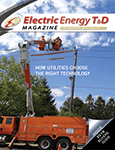What is Dynamic Line Rating?
Traditional operational limits of a transmission line are established through “static” transmission line rating methodologies. The common practice for transmission line rating is to select very conservative values for the environmental operating conditions of the line. The resulting static line rating is similarly very conservative.
Today, seasonally adjusted ratings (SAR) and ambient adjusted ratings (AAR) push upward a line’s traditional static ratings by simply acknowledging that more realistic environmental conditions exist. Dynamic Line Rating, or DLR, is a transmission line’s actual real-time or forecast power carrying capacity. It is based on the conductor’s operating temperature using real-time line behavior data and weather conditions. Dynamic Line Rating (DLR) is the natural and logical extension of the seasonal and ambient adjusted ratings trend. Why assume a line has only four ratings a year based on seasons when real-time data and line behavior modeling can provide reliable daily or even hourly ratings? This is especially significant as a line’s DLR is typically 10 - 25% higher than its static rating.
Numerous studies have shown this additional capacity provides opportunities in economic dispatch, trading, operations, and congestion mitigation. Application of DLR is also a powerful tool for improving contingency planning, cost effectively addressing lines with slow load growth, and deferring or eliminating the need for line upgrades or reconductoring.
Yet with all these economic advantages, DLR is sparsely deployed. The reasons are two-fold. First generation DLR systems presented numerous issues to early adopters, discouraging wider deployment. Secondly, demand drivers were either weak in the deregulating transmission environment, or were poorly understood.
Issues with First Generation DLR
First generation DLR systems all shared shortcomings which could be divided into three baskets; unusable data, installation complexity, and dependence on indirect measurements.
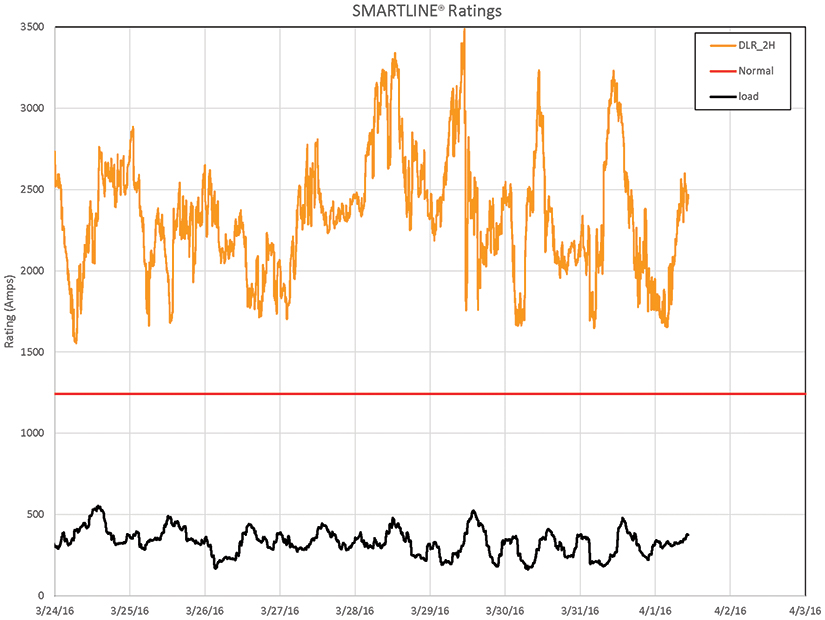
Traditional Dynamic Line Rating (upper line) constantly changes, limiting its usefulness
(click to enlarge)
Usable Data
- First generation systems provided only instantaneous DLR information in the form of a graph. By nature, DLR changes constantly, appears quite erratic, and is not practical for real-time operation. This is because instantaneous DLR changes based on rapidly varying parameters such as wind speed, precipitation, and cloud cover. As most DLR benefits are actually dependent on knowing the DLR in the future, real-time only DLR was of limited value.
- Data was often processed by the DLR provider with minimal information being provided to the utility. The lack of underlying data transparency often led to a lack of confidence in the resulting rating.
Complexity Issues
- Complex Installation: Some line sensors used by early DLR systems required the line to be de-energized during installation, and even required tower modifications to properly fit the sensor to the line. This introduces significant costs.
- Solar-charging: DLR sensors often communicated through battery-powered radios recharged via solar panels. A few days of cloudy or stormy weather, snow buildup, or even bird droppings could interfere with proper charging. As DLR requires continuous data feeds, the result was data dropout and compromised DLR system operation.
- Remote Installation: Optimized DLR systems often require monitoring of spans in remote or unpopulated locations, not close to existing communication infrastructure. This limits the practicality of cellular communications.
- Communications: Radio systems require proper antenna positioning and alignment. Connection of line mounted sensors and stand-alone weather stations increasing installation complexity.
Indirect Measurements
Accurate DLR depends on accurate and meaningful real-time data. Physical conductor data (current, temperature), spatial data (conductor clearance-to-ground), and weather are the most important parameters. First generation systems variously fell short in one or more of these areas.
- Physical conductor data was either not monitored on the actual conductor (e.g. current was measured at a remote substation), or was simulated (e.g., using nearby thermal replica devices).
- As conductors heat, they expand and sag, affecting conductor clearance-to-ground. Early systems used quantities such as tension, vibration, or optical sights to estimate sag. This was then used to obtain clearance estimates from look-up tables or standard formulas.
- Local weather stations were often used for accurate real-time weather data, but these stations could not provide forecast weather data.
Next Generation DLR Addresses First Generation Issues
Next Generation DLR, such as Lindsey’s SMARTLINE system, have evolved to address all these shortcomings. The result is a system which is simple to install, transparent in its ratings, and most importantly, usable and actionable. Using this system as an example, next generation DLR systems provide:
Meaningful Data: Conductor behavior data is now continuously collected by a self-powered, line mounted monitor. The device measures conductor current, conductor temperature, and the actual conductor-to-ground distance measurement via built-in LiDAR, eliminating the need for sag estimations. The sensor also monitors ground temperature and conductor vibration.
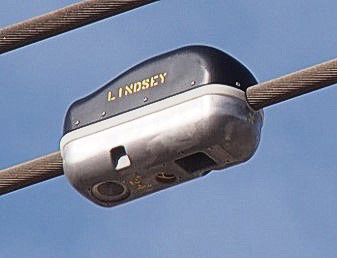
CNext generation DLR conductor monitor
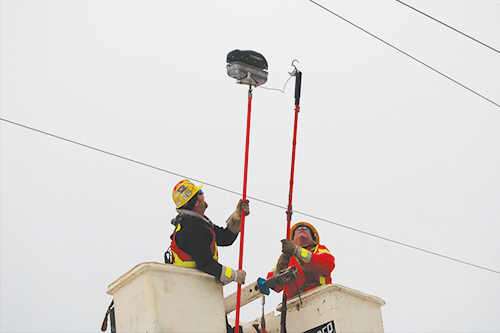
Live line installation of DLR conductor monitor in Cold Lake, Alberta, Canada
Simple Installation and Communications: Simple live-line installation and built-in satellite radio addresses numerous issues. Most importantly:
- Next generation conductor monitors may be installed on energized lines up through 765kV. Power supply and communications are self-contained.
- Built-in satellite radio provides the ability to communicate the monitored data from any transmission span, regardless of location. This eliminates the need for additional or nearby communication infrastructure or equipment.
- High data security. The satellite radio is built-in to the sensor and transmits only non-operational, measured data directly to the DLR software.
- Self-powered devices require no battery or external power source.
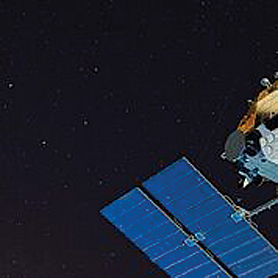
Reliable Dynamic Line Rating communications are provided via Iridium satellite network
Actionable Ratings: The system uses the line’s instantaneous dynamic line rating as a starting point, not the end result. Next generation DLR eliminates the continuous variability of first generation DLR and provides power line capacity ratings and forecasts that are easy to interpret and act upon in the control room, on the trading floor, or an engineer’s desk.
Further, line behavior, as it relates to weather and loading conditions, is learned over time. No one-size-fits-all formulas are used. This is combined with real-time data using reliability-based rating and forecasting techniques to provide ratings with 98 percent or greater equivalent confidence factors.
The SMARTLINE next generation DLR system provides a variety of ratings:
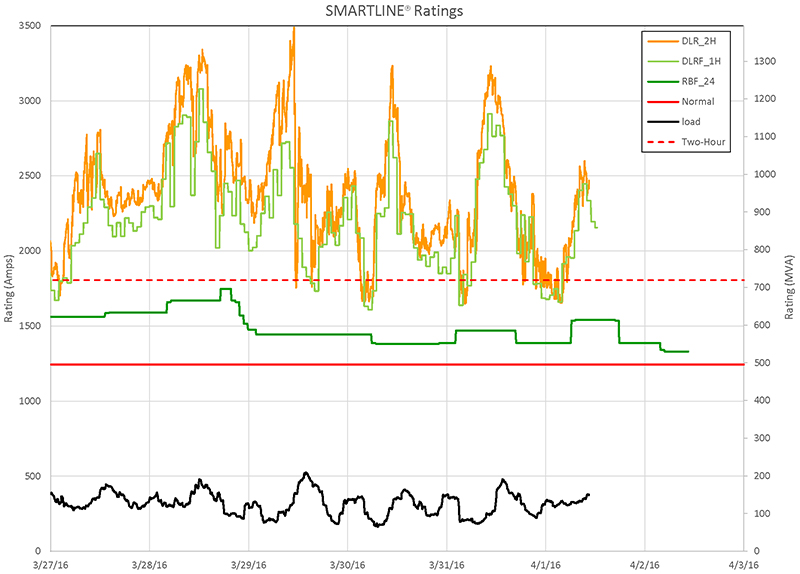
Next Generation DLR provides a full suite of ratings and forecasts.
Presented here graphically, the data is supplied as discrete ratings to the EMS system
(click to enlarge)
Next Generation DLR provides a full suite of ratings and forecasts. Presented here graphically, the data is supplied as discrete ratings to the EMS system
- SMARTLINE’s DLR is more useful than previous DLR ratings thanks to actionable clearance data. Recall the system’s line monitors provide built-in, LiDAR-based, clearance-to-ground measurements. This results in DLR ratings which obey clearance compliance limits in addition to traditional thermal limits. The result is the line’s maximum instantaneous current carrying capacity which ensures clearance requirements are not violated, while also eliminating the risk of conductor thermal damage.
- The Reliability Based Rating (RBR) is a statistically stabilized DLR rating and acts as a reduced-risk line rating alternative. RBR is designed for operators to ensure the transmission line is operating over time within both clearance and thermal parameters.
- Reliability Based Forecast (RBF) ratings are RBR line capacity ratings adjusted for forecasted future weather conditions. RBF ratings are tailored to address day(s) ahead energy dispatch and trading needs.
- The Block Forecast DLR (DLRF) rating is a forecast DLR value which is good for a fixed period of time (say one or two hours) based on forecasted weather conditions. For example a 2-hour DLRF rating issued at 1pm will provide a fixed line rating capacity that is good until 3pm (a two-hour window). A line could be confidently operated up to that limit during this time without violating its thermal limit or clearance.
- In addition, real-time streaming data views of all measured line parameters are also available.
Demand Drivers on Today’s Grid
Pressures on today transmission grid come from many corners, but hot topics such as competitive bidding, renewables, the Clean Power Plan, distributed energy resources (DER), and non-transmission assets (NTAs), underscore new opportunities that next generation DLR may address.
Reduced Budgets and Time Constraints
One of the well documented challenges for the power industry is the need for increased transmission line capacity with either existing or new infrastructure. However new transmission projects are faced with many challenges that often combine to stretch project timelines to ten or more years.
Therefore, upgrading and uprating existing transmission lines is often the preferred approach to increasing power transfer capacity over existing infrastructure. This approach also utilizes existing right of way (ROW) corridors, which are increasingly hard to obtain. Yet traditional reconductoring involves time and considerable investment. Consider In comparison:
- DLR can provide 10 – 25% additional line capacity for a very small fraction of the cost of reconductoring. It can be deployed quickly and become fully operational within days of installation.
- Slow-growth lines encroaching on their static ratings are even more difficult to justify upgrading. DLR is an ideal least-regrets approach to addressing such capacity shortfall.
- Installation of large-scale renewables and distributed energy resources can tax lines that may not have been challenged even a few years ago. DLR can address these issues quickly and inexpensively, even if only as a short-term measure until a larger scale project is engineered and approved.
Energy Trading Opportunities
The ability to accurately forecast higher levels of transmission capacity present many opportunities for energy trading.
- Additional capacity allows for larger trades or higher levels of trading.
- The additional capacity provided by DLR can relieve the congestion that results in congestion charges. If this congestion is regularly and consistently relieved, DLR may also reduce or defer the need for line upgrades or new construction.
- The capacity above static that DLR reveals could be considered a new, virtual parallel transmission path. In this light, DLR can be viewed as a non-transmission asset where any power transmitted down this virtual path could be monetized.
Grid Resilience
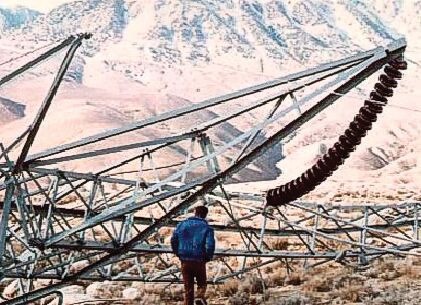
Weather or man-made events can stress transmission lines remaining in service
Grid resilience is a key operational topic for utilities today. How can DLR improve grid resilience? Consider a situation where one or more substations or transmission lines is lost to natural or man-made calamities. A resilient grid must be able to provide alternate transmission paths around the damaged portion of the grid. Alternatively, a generating facility forced off-line during peak load periods may require the utility to push additional power across lines that may already be heavily taxed. The ability to deal with either scenario is dependent on the capacity of those transmission lines still in service. In this case next generation DLR with reliable hour(s)-ahead to day(s)-ahead forecasting can provide both short- and medium-term “emergency-equivalent” ratings for all remaining in service lines.
As an additional consideration, uprating lower voltage lines for marginal contingency scenarios is often difficult to justify economically. DLR is a cost effective means to address line capacity upgrades where the economic case for normal contingency scenarios is difficult to make.
Increased Competitiveness for New Line Construction
Competitive bidding on transmission line projects in Canada and the U.S. can also be enhanced by next generation DLR. When DLR is integral to a line’s design, this additional capacity may be included. Savings would follow from a variety of sources including the use of a less expensive, smaller conductor. The lighter conductor loads may allow the use of lighter, less expensive line hardware and towers. Lighter towers and conductor loads may extend to less expensive foundations which may reduce construction cost and installation time.
This may provide an additional advantage to incumbent utilities. Installing DLR proactively on existing lines will provide an incumbent utility a history of operational DLR data and the additional capacity identified by the DLR deployment. When included in a competitive proposal this data offers strong rationale supporting the use of the additional DLR capacity as a base of the line design. While this logic could be used for any company submitting a proposal, the incumbent utility operator may have an advantage of validating the additional DLR capacity on their own system under the same climatic conditions which the proposed line may be constructed.
Summary
Next generation dynamic line rating systems can now provide utilities with meaningful, actionable transmission line capacity forecasts and ratings. Compared to first generation systems, the required monitoring equipment is simple and easy to install, and communications are reliable and maintenance free. The diverse needs of today’s transmission operators and dispatch authorities require additional transmission capacity from existing assets, but this capacity must be known in advance, not in real-time. Next generation DLR with its advanced capacity forecasting meets this need.
About the Author
 Jack McCall is Vice President of Sales for Lindsey Manufacturing with global responsibility all sales and business development. Before joining Lindsey, he was with American Superconductor (AMSC) and Cooper Power Systems. Jack has more than 25 year’s experience in the utility T&D business holding a variety of business development, strategic planning, product management, product engineering, and system engineering roles. He has published dozens of papers and holds two US patents. He has a Master’s degree in Electric Power Engineering from Rensselaer Polytechnic Institute and a BS in Electrical Engineering from Gannon University. He is a member of the Institute of Electrical and Electronics Engineers (IEEE) and the International Council on Large Electric Systems (CIGRE).
Jack McCall is Vice President of Sales for Lindsey Manufacturing with global responsibility all sales and business development. Before joining Lindsey, he was with American Superconductor (AMSC) and Cooper Power Systems. Jack has more than 25 year’s experience in the utility T&D business holding a variety of business development, strategic planning, product management, product engineering, and system engineering roles. He has published dozens of papers and holds two US patents. He has a Master’s degree in Electric Power Engineering from Rensselaer Polytechnic Institute and a BS in Electrical Engineering from Gannon University. He is a member of the Institute of Electrical and Electronics Engineers (IEEE) and the International Council on Large Electric Systems (CIGRE).



